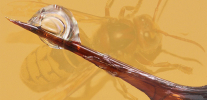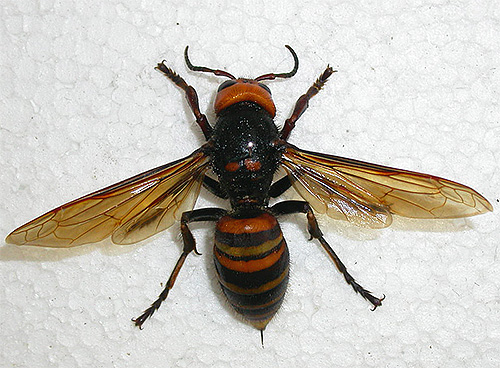
The Asian giant hornet is the largest hornet in the world. If he sits on the arm, then his wings completely overlap the palm, and the distance from the head to the end of the abdomen is fully consistent with the length of the adult's little finger. It is not surprising that in Japan this wasp is called the “sparrow-bee”: during its flight, the insect very much resembles a small bird.

It is safe to say that there is a connection between the size of the body of this giant and the severity of the consequences of meeting it: how big the biggest hornet is, how dangerous it is. Even a person who is not sensitive to insect venom may well die from his bites. Therefore, entomologists rightly consider the giant hornet one of the most dangerous insects in the world.
On a note
According to statistics, only in Japan as a result giant hornet bites annually from 40 to 50 people die.Similar data are given for individual districts of China, where relevant records are kept. In Japan, even sharks are not the cause of the death of so many people.
In addition, the huge hornet is a real scourge of many beekeeping farms. We have to deal with it with extreme caution because of the serious danger of being stung.
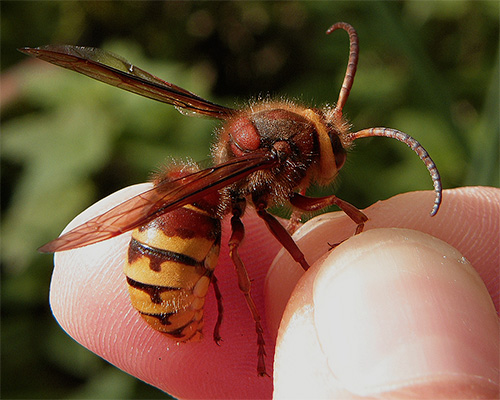
The relationship of a big hornet with a man has never been simple, and the heightened interest in him is often caused by a simple desire to tickle his nerves. Well, let's tickle ...
What does one of the largest wasps look like?
Giant hornets are large insects with a characteristic appearance for all wasps. Systematically they belong to the family The real wasps, which also includes the well-known and widely distributed paper wasps in the world.
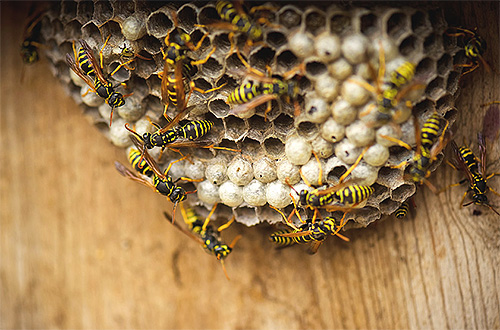
In science, the largest hornet is called Vespa Mandarinia, and this species itself is divided into several subspecies, differing from each other by some anatomical features and habitats.
For example, the well-known in scientific circles subspecies of the Japanese huge hornet (Vespa mandarinia japonica - its Latin name) lives only on the Japanese islands, Kuriles and the south of Sakhalin.Outwardly, it is difficult to distinguish it from the representative of the main species, but you cannot meet this insect on the mainland - it is endemic.

The length of the body of this hornet is 4.5-5 cm, but in some populations it is sometimes possible to find very large individuals - up to 5.5 cm. Within the family, its members differ little in size: the uterus and working hornets are about the same.
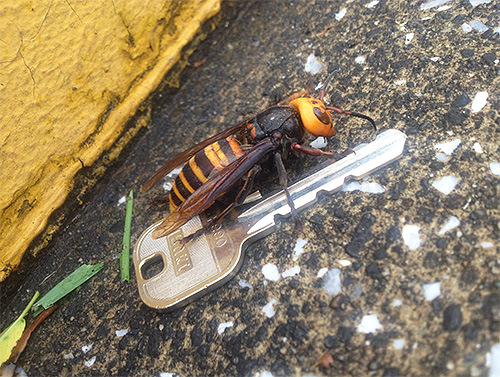
The largest hornet boasts a wingspan of up to 7 cm. At the same time, the coloring of the giant hornet is fairly simple and characteristic of all wasps: a yellow body, streaked with transverse black stripes, a brown base of the abdomen, a black head and yellow head.

But a very interesting and exceptional feature of these insects is that the largest hornets in the world have three additional eyes between the two main ones. On closer examination, it may even seem that this is not an insect, but a small robot, since the five eyes are an extremely unusual sight for humans.
Below is a photo of the largest hornet. On his head, extra eyes are clearly visible:
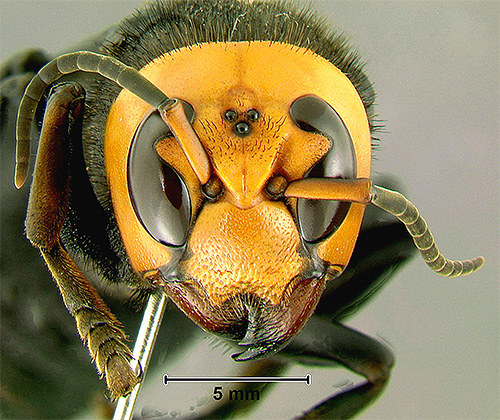
It is interesting
Hornets are easily confused with scoliums. These are large wasps, leading a solitary lifestyle.Representatives of the largest species of cholium exceed the size of even the huge Asian hornets and reach a length of 6 cm. The simplest difference between cholii and hornets is their coloring. The former are usually black in body color, rarely with metallic blue, and the latter are never black.
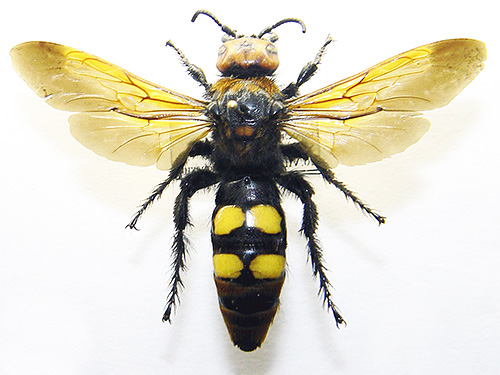
Danger of a giant hornet
Giant hornets are extremely dangerous. Impressive dimensions allow these insects to have a long, up to 6 mm, sting, due to which they can inject a much larger dose of poison into the wound in one bite than ordinary hornets.
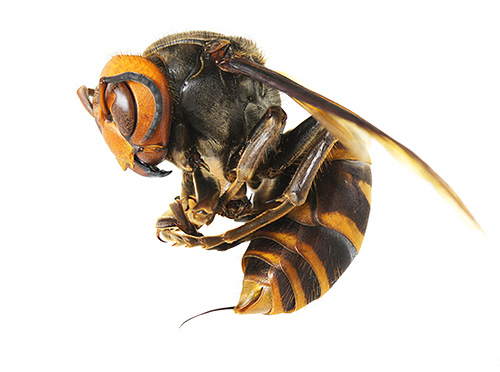
In addition, a huge hornet, angered or protecting the nest, can use its sting several times in one attack, and therefore in the end this repeated sting becomes equivalent to the bites of 5-6 of its European relatives.

The poison of a giant hornet causes acute throbbing pain and leads to almost instantaneous edema, followed by inflammation of the tissues. In parallel, the main symptoms of the victim may appear headaches and shortness of breath, as well as rapid heartbeat.
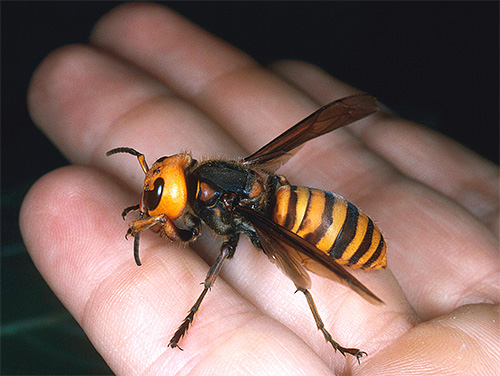
Feedback
“A tiger bee bit me when I was working on a farm. The bite was on the leg, below the knee.At first I was frightened that it was some kind of snake, because it was very painful, but then I saw a bee, and immediately fell into the water. My leg swelled up quickly and I could not bend it, but the worst was the pain. I literally sat and yelled, because I couldn't do anything else. Other workers helped me ride the bike, and the boss took me to the hospital. There was already a huge hematoma at the site of the bite, and they told me that if I had been delayed, I could have lost my leg. Only in the hospital I was given an injection, from which the pain had gone a little. Two days after that I had a high fever and fever. ”
Vagar Msahari, Balangir
Such a terrifying pain syndrome is explained by the fact that the biggest hornets are owners of the so-called mandorotoxin, a powerful poison that acts on the nervous system and promotes the appearance of additional symptoms spread throughout the body. However, the most dangerous thing in the bite of a giant hornet is not even hellish pain, but an allergic reaction following it.
In the venom itself contains a large amount of histamine - a substance responsible for the rapid development of allergies. In addition, the components of the hornet's poison stimulate the release of its own histamine by the cells of the tissue, which was directly stung and began to swell.
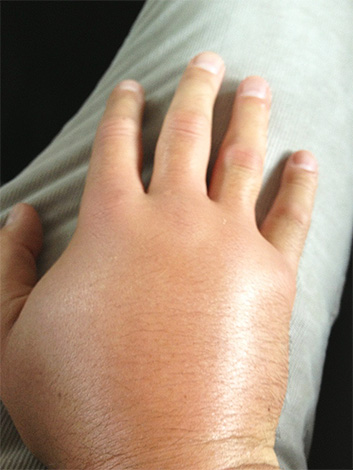
The standard response of the human body to the bite of a giant hornet is extensive inflammation, redness and hardening of tissues, an increase in lymph nodes and an increase in temperature. If the victim is particularly sensitive to the poisons of insects, after the bite of the world's biggest hornet, he can develop anaphylactic shock.
In this most life-threatening situation, the countdown does not go on for hours, but for minutes. If the victim is not delivered to the hospital in time, the probability of death is very high.
Feedback
“Several times a year, local residents affected by Vespa Mandarinia bites come to our hospital. This year there were already two, last year - four people. One of those four died as the hornets stung his neck, and because of the swelling he could not breathe. He was brought to the hospital already in a state of clinical death, and we could not start the work of the heart after asphyxiation. ”
To Nga, Maoming
Lifestyles and habitats of giant hornets
The biggest hornets lead the same way of life as their other relatives. They live mainly in forests, keep close enough to water sources.For reproduction, the female begins to build a nest, in the first honeycomb of which she lays eggs, and then grows out working hornets.
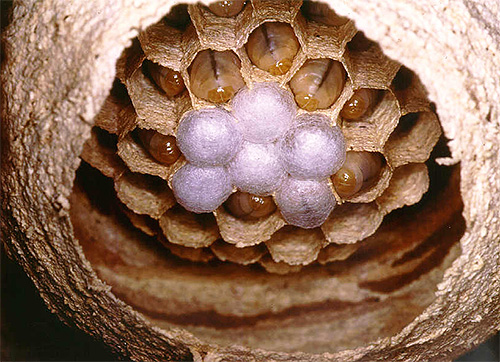
After her duties are reduced only to the continuous laying of eggs, and all work in the nest falls on the shoulders of working individuals.
Their nests Hornets are built from the young bark of trees, which, chewing, turn into a parchment-like mass.
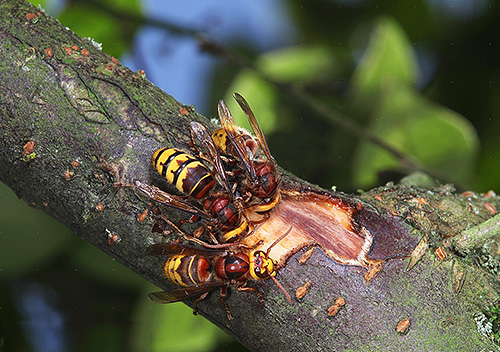
Externally, the nest resembles a huge light gray fruit, whose height can reach 70-80 cm, and the width - up to half a meter. Hornets can place their dwellings as openly, hanging them from the branches of trees, and hide from prying eyes in hollows, caves and burrows.
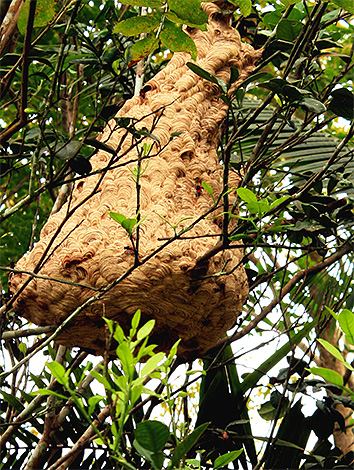
Once a year a large number of females and males appear in the nest. In conditions of severe overpopulation, they fly out of the nest, swarm and mate. After that, the females go to look for places for new, already their own, nests, and the males die.
Little about predatory habits
Like all other hornets, Asian giants are active predators. They feed and feed their offspring mainly animal food, most often - other arthropods. Do not disdain these huge predators and their relatives, who have more modest size.
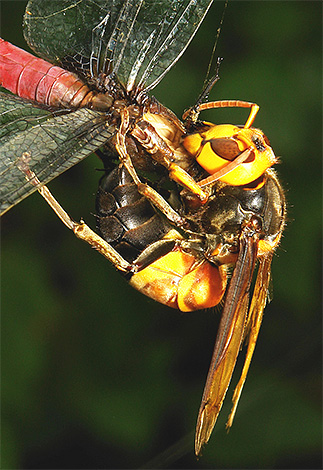
The status of “the biggest hornet in the world” is completely justified by this insect: attacks on the nests of other, smaller species of hornets are quite common. In this case, the giants completely destroy the homes of their relatives and destroy all working individuals and larvae.
Especially often giant hornets attack bees, hunting not only the owners of the hive themselves, but also their honey (adult hornets love sweets very much). 30-40 hornets can in a few hours completely exterminate a bee family of 20-30 thousand bees.
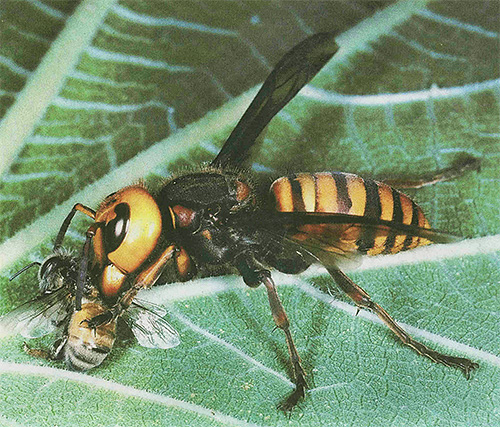
As you can see, the forces under such an attack are unequal, so the beekeepers of China and Japan are very actively destroying the nests of giant hornets and by all means trying to scare them away from apiaries.
What to do if stung by a giant hornet
The biggest hornet in the world can easily meet you on holiday in China, Nepal, India, Malaysia or Japan. It is worth noting that, and without leaving your country, you can also come across a giant hornet: it inhabits Primorye in sufficient numbers.
There is one recommendation that allows you to remain safe and unharmed when meeting a huge insect: you should not make sudden movements and wave your hands.In relation to man, the giant hornet is peace-loving and will never attack first without special reason.
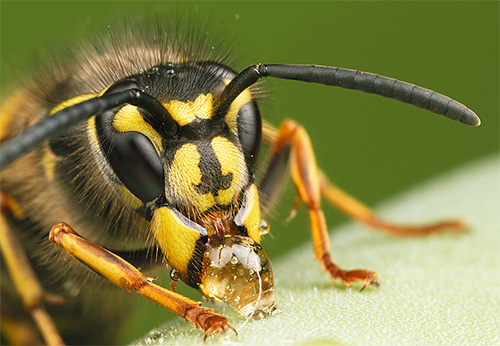
Usually, a person’s attempt to catch an insect or take a close-up picture of the attack becomes the cause of the attack, and it’s not a surprise if the hornet attacks while trying to view ’its nest.
In order to avoid various unpleasant consequences, you just need to move away from the place where the hornet was seen - this will be the best option.
However, let's define the algorithm for helping the victim if the bite does occur.
- It should immediately attach to the site of the defeat cold, and preferably - wet sugar. This will slow the spread of poison through the tissues.
- If possible, you need as soon as possible to make a stung injection of an antihistamine - Suprastin or Dimedrol (the injection of adrenaline will be optimal).
- After this, the person must be laid so that his head is not raised. Do not forget all the time to carefully monitor the appearance of symptoms of an allergic reaction!
- With the rapid spread of edema, the emergence of asthmatic breathing, increasing the temperature of the victim must immediately be taken to the hospital, if necessary, doing artificial respiration along the way.
In most cases, the bites of giant hornets happen all the same because of the man's carelessness. With reasonable behavior and due observation, this large insect can always be noticed before it feels danger, and retreat. This will be the best outcome of meeting a reasonable person with the largest hornet in the world.
Interesting video: Asian hornet attack on a beehive
Giant hornet in the hands of man
And on this video, the powerful jaws of the giant hornet are clearly visible.


